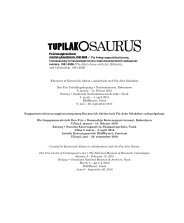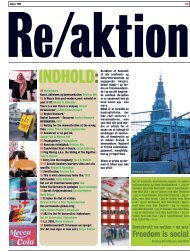tupilakosaurus - Print matters!
tupilakosaurus - Print matters!
tupilakosaurus - Print matters!
You also want an ePaper? Increase the reach of your titles
YUMPU automatically turns print PDFs into web optimized ePapers that Google loves.
TUPILAKOSAURUS<br />
gunngisaannassaaq. Soorlumi Kirsten Thistedip<br />
erseqqissaraa: “…nunasiaatitaasut oqartussaasut<br />
pissusii issuarniaatigalugit pissutsit taakku<br />
pineqartup ilaatigut ‘oqartussaaffiiartarpai’:<br />
pissaaneqangaarnerannik arsaarlugit. Nunasiaatillit<br />
mitallernermut sioorasaarinermullu<br />
taamaattumut illersorsinnaanngillat: nunasiaatigineqartut<br />
sinnera ulikkaartarpaat namminneq<br />
pigisaminnik.”<br />
Tassa Arke arlariinniiginnarsimanngilaq –<br />
illuatungaani kalaaliusutut illuatungaanilu<br />
qallunaatut silarsuarmini. Aammali ilisimatuussutsip<br />
katersugaasiviillu oqartussaaneri naallerarpai.<br />
Malitassaqqissunik oqaasilioriaatsimigut<br />
killissaminillu qaangiinissaminik sioorasaarinermigut<br />
(eqqornerusumilluunniit issittumi<br />
silaaruttutut kamanneq – kingusinnerusukkut<br />
tikinneqarumaartoq) “inuiannullu ataneqmik”<br />
immersuinermigut katersugaasivik isaterpaa<br />
europamiut oqaluttuaata ilaatulli, oqarlunili<br />
oqaluttuat arlallit pineqartut – eqqortoq naakkittaatsoq<br />
ataasiinnaanngitsoq, tassaallutilli<br />
naakkittaatsumik isummernernik illuatungeriinnernillu<br />
imallit amerlaqisut, oqaluttuarujussuup<br />
imarisinnaanngilluinnagai.<br />
“Sioorasaarineq” immaqa erseqqinnerpaavoq<br />
videoliami Tupilakosaurus-imi (1999), saqqummersitsinermullumi<br />
uunga atsiunneqarsimalluni.<br />
Video immiunneqarsimavoq illuatungeriit<br />
amerlaqisut sammillugit: tupilak paarmortumut<br />
(-saurus), oqaluttuatoqqap inuttaa oqaluttuarisaanermik<br />
qanganitsamik ilisimatusarnermut,<br />
eqqumiitsuliortoq ilisimatuumut, arnaq<br />
angummut, nunap inuia qaammaasalimmut,<br />
inuk simersoq qaqortumik amilimmut, avammut<br />
iliuusilik silatusaartumut, timi ilisimasaqarnermut,<br />
susaq susumut, assigisaallu.<br />
Illuatungeriissitsinerit soorunami Arkep nassaarisarinngilai.<br />
Takusassiariinnarpaa uagut<br />
nunavissuarmiut eqqarsartaaserput, tassalu<br />
suulluunniit iluatungeqartut, illuatungeriillu<br />
imminnut mattuttartut. Arlariillutik ataatsimut<br />
peqatigiissinnaapput, aammali imminnut assortuussinnnaapput,<br />
kisiannili kattussinnaanngillat<br />
kattutinngisaannassallutillu.<br />
Eqqarsartaatsimut tassunga illuatungiliullugu<br />
Arke “tukattumik” periaasiliorpoq,<br />
taamalu siunertaqarluni eqqumiitsuliornermik<br />
ilisimatusarnermini ilannguppai pissusitoqqat<br />
“ilisimatuujunnginneq” aamma “kusanartulerinnginneq”:<br />
misigissutsit, eqqumiitsuliornikkut<br />
naleqanngissuseq, “inuiannut ataneq”, politikki<br />
kingunerlutsitsinerillu. Periaatsiminilumi ilisimatuussutsip<br />
naleqartitsinermi nammineer-sinnaassutsimik<br />
piumasaanik soqutiginninnginnermigut<br />
tarnikkulli erloqissuteqarnernik inunnillu<br />
ataasiakkaanik ilanngussinermigut pilersippaa<br />
– Juhl-ip paasisai issuaqqillugit – “kalaallit<br />
ilisimasamikkut itsarnisarsiornerat”.<br />
Inuit ataasiakkaat soorunami silinnerusumik<br />
paasineqassaaq, soorlu Erik Gantip eseqqissaraa<br />
“assilisaasa siunertarisimanngisaannannguatsiarpaat<br />
taakku namminneerlutik<br />
oqaluttuarnissaat. Akerlianik tassarpiaapput<br />
nammineq allallu akunnerminni siunertanik,<br />
isummiussinernik pimoorussinernillu nalunaaruteqaataasussat.”<br />
THEME SECTION 2: TUPILAKOSAURUS<br />
The theme section Tupilakosaurus looks<br />
at Pia Arke’s artistic method and illuminates<br />
some of the central problematics<br />
and devices that she worked with. It<br />
shows and reproduces works that mainly<br />
derive from an exhibition at the Museum<br />
of Contemporary Art in Roskilde in 1999,<br />
to which Arke contributed with a veritable<br />
exhibition within the exhibition. But<br />
it also contains a couple of thematically<br />
related black-and-white silver gelatine<br />
prints from the series Perlustrations 1-10<br />
(1994) (sometimes also referred to as<br />
Nature Morte) and a showcase with research<br />
material that also points to vital<br />
features in Arke’s artistic research.<br />
All the works in An installation that<br />
has to do with histories, which was the<br />
title of her contribution to the exhibition<br />
in Roskilde, process a given issue<br />
of the series of scientific monographs<br />
Meddelelser om Grønland [Communications<br />
on Greenland], which, since 1878<br />
and with two or three volumes each year,<br />
has published international research on<br />
Greenland and expedition reports from<br />
Greenland. More precisely the works take<br />
possession of the pictorial part of Geologist<br />
Eigil Nielsen’s treatise Tupilakosaurus<br />
heilmani n. g. et n. sp. from 1954<br />
and remove the illustrations from their<br />
context – the scientific tradition, and in a<br />
further sense the colonial advances into<br />
foreign territories that have for centuries<br />
made the tradition possible – to place<br />
them inside the museum’s white cube.<br />
That Arke draws science into the<br />
space of art is not just a whim, but a<br />
carefully considered method designed to<br />
show whether the two phenomena could<br />
be thought to have pulled together in<br />
the same colonial direction; what their<br />
mutual relationship (historically and<br />
currently) looks like; and to what extent<br />
one can separate the two phenomena<br />
and put selected parts together to form<br />
a new and more useful practice that<br />
might be called artistic research.<br />
The strength of artistic research is,<br />
according to Carsten Juhl, that such<br />
research is conducted inside the subject<br />
being investigated and not above it as<br />
is customarily the case with research.<br />
It was precisely research of this kind<br />
that was involved in An installation that<br />
has to do with histories. The elements<br />
and the way they were installed were<br />
simple, stringent and of a considerable<br />
museological coolness. But all of a sudden<br />
over the entrance to the installation<br />
there hangs a big plucked thigh bone<br />
and breaks the illusion of the severely<br />
museal setting.<br />
The bone highlights Arke’s ambivalence:<br />
on the one hand, you are expected<br />
to practise in accordance with the norms<br />
in force. But, on the other hand, you as<br />
“ethnic” cannot transcend the category<br />
of “ethnic artist” and become an “artist”<br />
pure and simple. You can, in other<br />
words, mimic the Europeans, but in<br />
the nature of things never become just<br />
like them. For, as literary critic Kirsten<br />
Thisted points out: “…at the same<br />
time as the colonised mimic the forms<br />
of authority, they in a certain sense<br />
‘de-authorise’ these forms: deprive them<br />
of their monumental power. Colonial<br />
authority cannot protect itself against<br />
this mockery and the threat that the<br />
colonised will fill out the text with their<br />
own content.”<br />
Thus, Arke did not just have a foot in<br />
each camp – one in her Greenlandic and<br />
the other in her Danish world. She also<br />
had a bone to pluck with the authority<br />
of science and the museum. With her<br />
choice of a canonised formal language<br />
and with the threat of going off the deep<br />
end (or rather going piblokto – but more<br />
about that later) and filling her form<br />
with “ethnic” content, she dismantles<br />
the museum as a piece of European<br />
history and says instead that it is a<br />
matter of several histories – not of one<br />
raw truth, but of raw quantities of<br />
meaningfulness and opposition that the<br />
big history is quite unable to contain.<br />
Perhaps the “threat” comes most<br />
clearly to expression in the video work<br />
Tupilakosaurus (1999) from which the<br />
present exhibition derives its name.<br />
The video is structured around a large<br />
number of binary oppositions: tupilak<br />
vs. reptile (-saurus), mythical figure vs.<br />
prehistoric science, artist vs. scientist,<br />
woman vs. man, original vs. civilised,<br />
coloured vs. white, dynamic vs. downto-earth,<br />
body vs. knowledge, object vs.<br />
subject, and so on.<br />
These are of course not polarisations<br />
that Arke has invented. She merely<br />
puts on stage a key concept in our<br />
continental philosophy that states that<br />
everything has its opposite, and that<br />
the oppositions are mutually exclusive.<br />
Together they can form a unit, and they<br />
can engage in conflict with one another,<br />
but they are and remain irreconcilable.<br />
To counter this mindset Arke developed<br />
a “messy” practice, in which she<br />
quite deliberately incorporated traditionally<br />
“unscientific” and “unaesthetic”<br />
quantities in her artistic research: feelings,<br />
kitsch, the “ethnic”, politics and<br />
the traumatic. And precisely because<br />
her practice disregarded the demands<br />
of science for value-free research and<br />
included involvement and the personal,<br />
she was able to set up a – to draw once<br />
again on Juhl’s insights – “Greenlandic<br />
archaeology of knowledge”.<br />
The personal, it should be noted, is<br />
to be understood in an expanded sense,<br />
for as critic Erik Gant points out: “it has<br />
probably never been the idea that her<br />
pictures should speak for themselves.<br />
On the contrary, they are meant to<br />
function precisely as the medium for<br />
all sorts of intentions, messages and<br />
commitments in the relation between<br />
herself and others.”<br />
19




